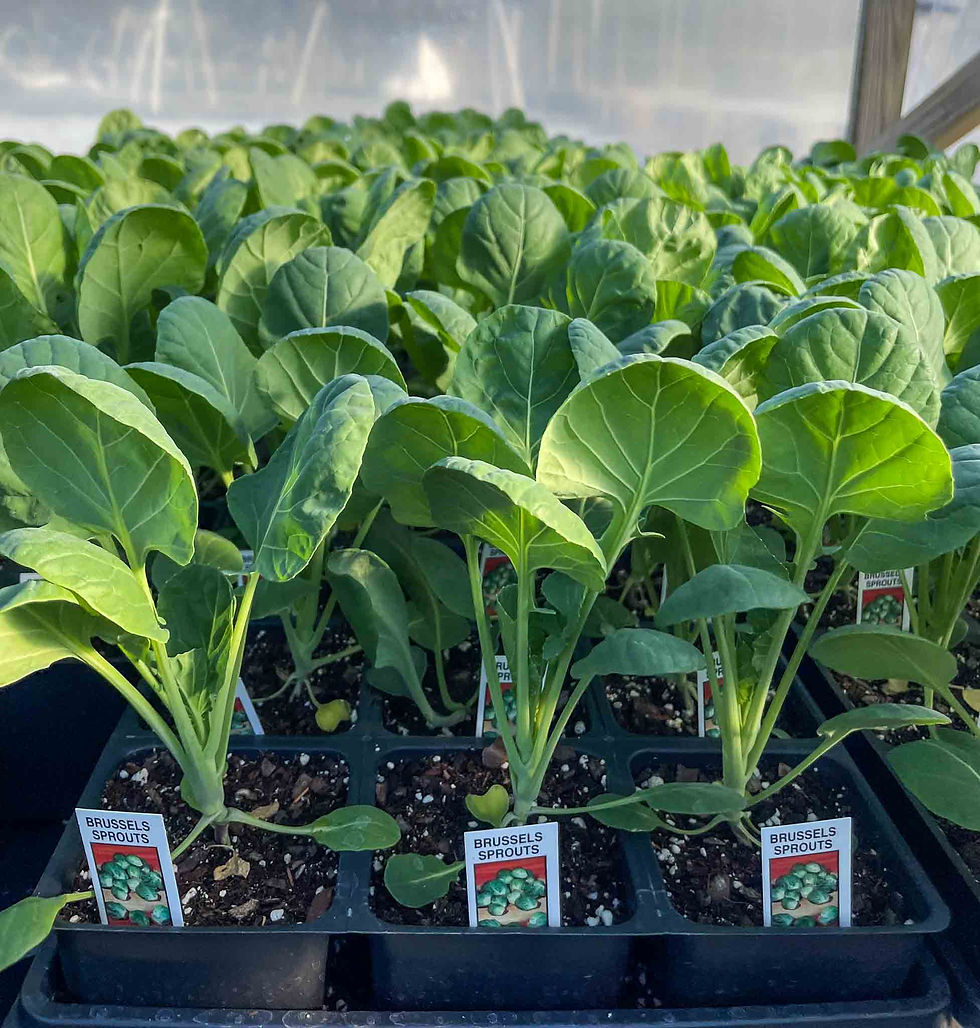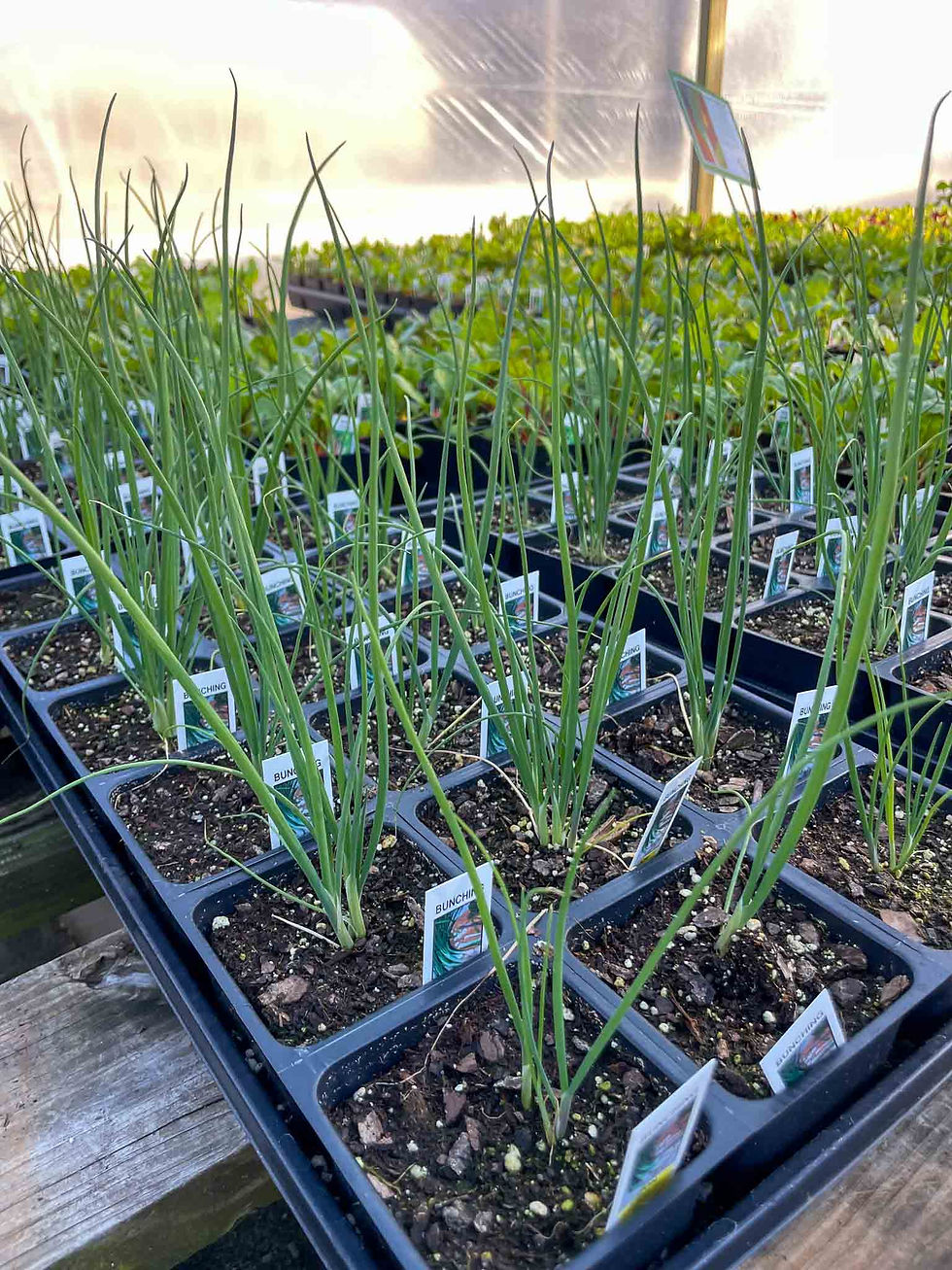Guide to Cool Season Veggies at Painters Greenhouse
- Painters Greenhouse
- Mar 14, 2023
- 7 min read
Updated: Mar 18

Like many gardeners in winter, we also daydream of various crops we’ll grow for the coming season. At Painters we spend the off-season researching vegetable varieties that perform well in our area. We gather feedback from customers and employees and research to find varieties bred to be adapted to the climate, soil, and pest/disease pressures of our area. To match our extensive research, we include detailed signage with information for each variety we offer (a big thanks to Nora for her hard work with that!).
This week we are highlighting cool-season veggies. When our doors opened the first week of March we made sure to have our whole selection of cool-season veggie starts available to customers. Many gardeners plant cool-season veggies before March, and that’s a good call! Our starts are mature enough to be transplanted directly into your garden–we've grown them to a healthy (and beautiful!) size. We try to select short-season or early maturing varieties of cool-season crops to help customers reap a bounty within the small window we have between now and summer. We also try to select varieties that can withstand warmer temperatures and are slow to bolt. All cool-season crops are grown in 3.5” pots, 18 pots to a flat, and priced to move--we often feature specials on veggies by the flat, so make sure to check out our New this Week page to view the latest price updates.

As Winter mellows into Spring, don’t be fooled that the cold is totally gone. We are still susceptible to frost ± 10 days from April 13th. This week is certainly showing us that the cold nights aren't gone yet! Check your average last (and first) frost days in your area here: https://products.climate.ncsu.edu/freeze/map.php. We plan to have our warm-season vegetable starts available for sale closer to mid-April, but check out our Edibles page for our full growing list!
Now onto the veggies!
Jump to:
BRASSICAS
Also considered members of the cabbage family, this includes some of the most widely cultivated (and often most nutritious) vegetables throughout the world. Plants in the Brassica family love temperate weather, thrive in well-drained, nutrient-rich soil, and love a healthy dose of nitrogen.

Bok Choy ‘Joi Choi’ – F1
A vigorous, white-stemmed bok choy (or pak choi) that grows up to 15” tall. Slow-bolting, and tolerant of both heat and cold makes it adaptable and easy to grow. An essential part of Chinese cuisine for thousands of years. Mild mustard flavor with a background sweetness – great steamed of stir-fried.

Broccoli ‘Imperial’ – F1
Head-forming broccoli. Excellent heat tolerance and continues to produce heads during longer days, making it suitable for summer harvesting. Harvest when heads are tight, before flower buds start to open. Stores well.

Brussels Sprout ‘Jade Cross’ – F1
An All-American Selections winner. Uniform small sprouts (up to 1”) that taste delicious. Plants are compact (<30”). Brussels Sprouts are best planted in fall for a winter harvest (tastes better after a frost!), but they can also be grown in mild springs and benefit from moist, rich, cool soil.

Chinese Cabbage ‘China Express’ – F1
Napa type Chinese cabbage. Produces a barrel-shaped head averaging 3-5 lbs. with 10-12” diameter! Sweet, flavorful, and crisp - perfect for kimchi and stir fries. Resistant to mild frosts and disease, slow to bolt.

Cabbage ‘Ruby Perfection’ – F1
Red/purple cabbage resistant to thrips and black rot. Heads grow to 6 lbs. and are ready to harvest in late summer. Full of anthocyanins and phenolics – good for your memory and immune system!

Cabbage ‘Savoy Ace’ – F1
A treat for home-growers, as these densely wrinkled cabbages are usually not available in stores since they don’t ship well. Tender and delicate, this type of cabbage cooks quicker than smooth-leaf varieties. Aesthetically appealing and considered to be the best tasting of all the cabbages! Medium-sized heads are early to mature.

Cabbage ‘Stonehead’ – F1
Grey-green round heads of smooth, tightly packed leaves growing up to 6” and 6lbs. Resistant to splitting, yellowing, and black rot. Widely considered to be the easiest cabbage to grow – great for slaws and sauerkraut!

Cauliflower, Romanesco ‘Veronica’ – F1
As visually striking as it is tasty--perfect for lovers of both flavor and math. It is known for its striking, fractal-like heads with spiraling, chartreuse florets that form pointed, turreted spears. The heads continue to mature while outer spears are harvested. Also known as Fibonacci broccoli!

Cauliflower ‘Snow Crown’ – F1
Snow white heads up to 8”. Matures quickly and ready for harvest in summer. This is the go-to variety for many gardeners as it’s vigorous and reliable. Sweet and mild – great raw, roasted or steamed!

Collards ‘Flash’ – F1
A dark green variety known for its vigor, dependability and high yield. Fast regrowth offers repeated harvests for gardeners. Mild and sweet, and even sweeter after a frost.

Kale ‘Toscano’
This Tuscan kale is an Italian heirloom. It’s also known as lacinato or dinosaur kale. Leaves are extra-dark green and savoyed. It is tolerant of heat and frost, grows up to 3’ tall and 2’ wide. Rich and tender, with a softer texture than curly kales.

Kale ‘Vates’
Also called Blue Scotch Curled Kale, delicious, dark green-blue, crinkled leaves are perfect for making kale chips, eaten raw, in salads or cooked in many different ways. Among the most nutrient-dense vegetables on the planet! Compact, slow-bolting, hardy in heat and cold (even frost tolerant).

Kale ‘Beira’ – F1
Known as Sea Kale or Portuguese Cabbage. The taste and texture of the leaves are similar to collards. These vigorous plants grow up to 2’ tall and wide and perform best in the cooler weather of spring and fall. Midribs and stems can be peeled and eaten like celery. This is the traditional kale used to make Portuguese kale soup.

Kale ‘Red Russian’
Silvery-green, oak-leaf shaped leaves with bright purple stems. Grows up to 3’ tall and remain tender when large. This type of kale is more tender, smooth and sweet than other kales – great in massaged salads!

Kohlrabi ‘Kossak’ – F1
Hybrid variety with massive bulbs–up to 10'' and 10 lbs–although best when harvested around 8.” These vegetables are excellent for storage. They are sweet and juicy, with no woodiness, even when bowling-ball sized! Delicious raw or in sautés and stir-fries; versatile and nutritious!

Mustard ‘Miz America’ Mizuna – F1
Deeply lobed, wine-colored leaves are tasty while also being ornamental (great for combo pots!). Leaves are crunchy with a mild mustardy flavor and can be eaten as baby greens or fully-developed leaves. Toss a small handful in with milder greens for a nice zest!
ALLIUMS
Latin for “garlic,” members of this family include onions, garlic, leeks, scallions, chives, and shallots.

Leek ‘King Richard’
Beautiful full-sized leeks with non-bulbing shafts up to 12”. This variety has a sweet, mild flavor excellent for soups, stews and salads – will be ready to harvest in summer.

Bunching Onion ‘White Lisbon’
The most popular variety of non-bulbing bunching onions since the 1700s! Tolerates both heat and cold and reliably thrives in a wide range of soils and conditions. Smooth, succulent stalks have a mild, zesty flavor.
GREENS
From fresh lettuces for salads, to spicy arugula and bright hints of rainbow chard, growing leafy greens in your garden is extremely rewarding!

Lettuce ‘Buttercrunch’
Small, loose heads of deep green, wavy leaves. Leaves have a velvety texture and sweet flavor. Harvest outer leaves first to encourage growth of inner leaves. Does great grown in containers.

Lettuce ‘Parris Island’
An heirloom Romaine (aka Cos) lettuce with vase-shaped heads of dark green, tender leaves. Disease resistant, slow to bolt, and exceptionally nutritious. Named after Parris Island, a small island off the coast of South Carolina.

Lettuce ‘Encore Mix’
A mix of red and green lettuces varying in shape, color and texture. This mix includes Green Oakleaf, Red Oakleaf, Green Romaine, Red Romaine, Lollo Rossa, Redleaf, and Bibb lettuces. A great option for a diversity of greens. Suitable for outdoor production, in containers, or in the low-light conditions of hoop houses and greenhouses. A “cut and come again” technique of harvesting baby greens works for this lettuce, as most lettuces in the mix will regrow.

Lettuce ‘Lolla Rossa’
Heavily frilled leaves with dark red edges add fantastic texture and colors to salads. Harvest the outer leaves first to encourage growth of inner leaves.

Lettuce ‘Salad Bowl Green’
Long frilly leaves are tender and flavorful, perfect for salads. Award-winning variety tolerant of heat, frost, and tip burn. Harvest the whole heads when large, or harvest outer leaves a bit at a time.

Spinach ‘Bloomsdale’ (savoy)
A tried and true heirloom variety, a favorite for over a hundred years. Thick, crinkled leaves stand upright which keeps the leaves clean, and harvesting is a breeze! Fast-growing and slow to bolt. Delicious raw or cooked.

Swiss Chard ‘Bright Lights’ – F1
Leafy green with brilliantly colored stems in shades of gold, pink, white, purple, orange and green. Sweet and delicious, harvest young for salads, or use larger leaves for stir-fries and sautés.

Arugula ‘Astro’
A peppery, nutty green that lends a punch of flavor to pizzas, salads, pesto, and pasta dishes. This variety is heat-tolerant and grows well in full sun. White-pink flowers are also edible and add a lovely garnish to salads or stir-fries.
SEEDS

Some vegetables have sensitive roots and do not respond well to transplanting from a pot into the ground. Some examples are radishes, corn, peas, beans, squash, melon, cucumbers, okra, and others. We do plan to grow limited quantities of squash, melon, eggplants, cucumbers, and okra for customers, but we also offer Sow True Seed packets for the vegetables that do best by direct sowing. Supplies are limited. Download this document for a current listing of available seeds:
[NOTE] F1/Hybrid Varieties: F1 denotes a plant that is a first generation offspring of two individuals of two different plant varieties. These are more artificially-bred than plants that are grown from open-pollinated (OP) seeds. F1 hybrids are usually bred to create a plant with particular traits to cater to a specific desire (i.e. disease resistance, fruit/flower color, sweetness, dwarf form/habit, larger fruit, etc.). If you allow F1 varieties to produce seed the plants from these seeds will not be true to the parent plant. The debate of F1 vs OP is heated. We understand, as a greenhouse, the importance of heirloom or open-pollinated varieties to allow customers to produce one’s own seed supply with diverse genetics. We also want to serve our customers' desires, and we find that many are looking for popular hybrid varieties that have become a staple in many home gardens.
.png)